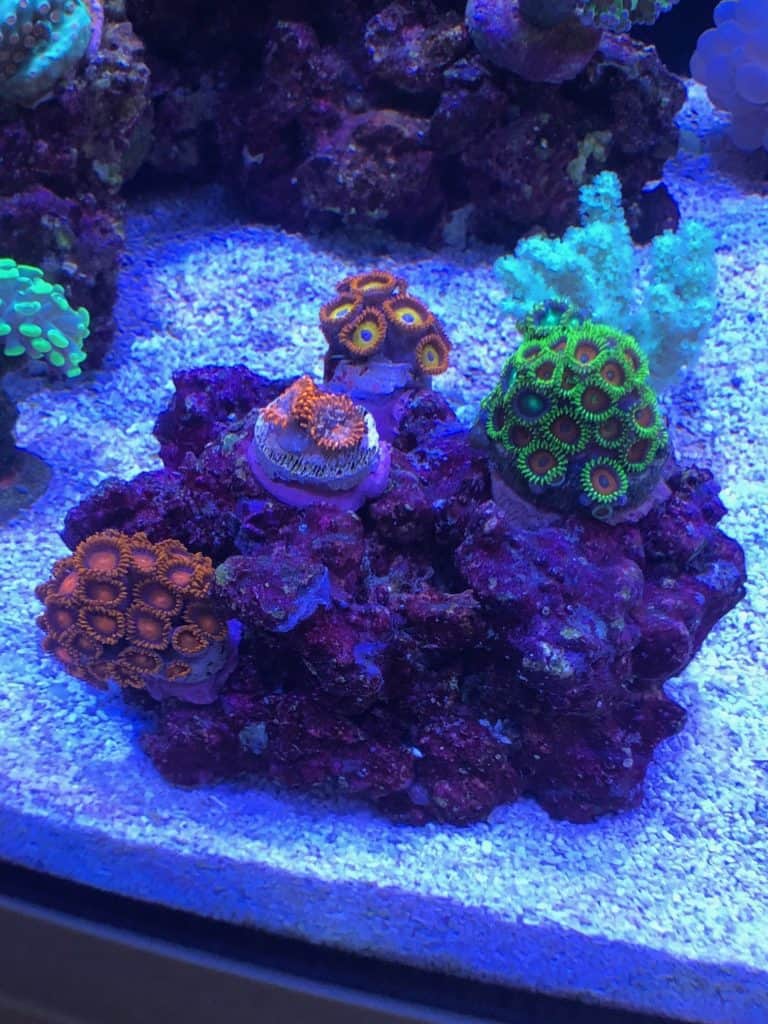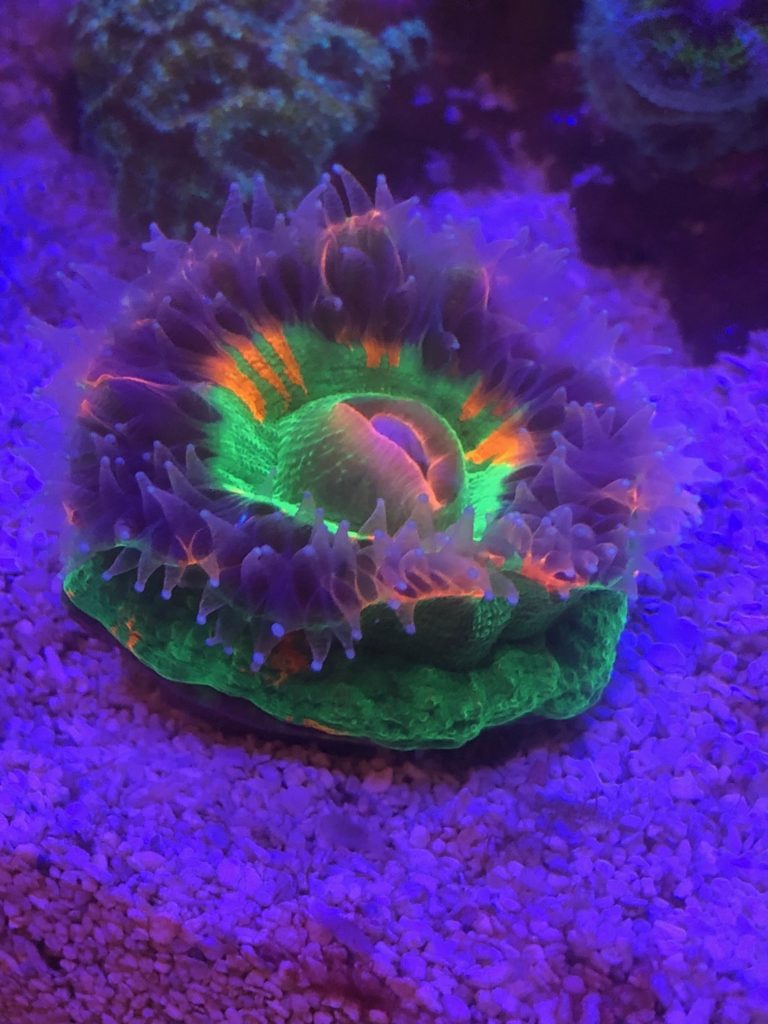‘How many watts of LED light for reef tanks?’ is the wrong question. Please don’t make the mistake of getting this information wrong! The health and colorization of your corals depend on it!
The old school watts per gallon or watts per surface area does not equate with LED fixtures. Lighting performance should be judged by how much photosynthetically active radiation (PAR) goes into the tank. The graph of PAR levels at various depths within an aquarium is known as a PAR map. Watts per gallon does not apply to LED fixtures.
Metal Halide Lighting (Example)
How many watts of light for reef tanks used to be a rule of thumb for lighting like metal halide. This rule of thumb would let you understand the lighting intensity your fixtures would provide your specific reef aquarium.
A single metal halide fixture can produce hundreds of watts of energy, which can allow you to reach high PAR values. The recommended wattage would vary depending on the size and shape of your reef tank. For example:
- 175 Watts is used for 20-inch deep tanks with SPS or mixed-type corals.
- 250 Watts is used for 30-inch deep tanks with SPS or mixed-type corals.
Fortunately or not, this rule of thumb is of no value when discussing LED fixtures.
Don’t use visual brightness to guess the amount of PAR
The human eye sees a different spectrum of light than what your corals use for photosynthesis. The human eye sees somewhere about 560 nanometers as the brightest. We struggle to see the light in the blue and UV range – and corals use a lot of light from the blue spectrum.
Therefore, If you use the visual brightness from the human eye to judge the amount of light, you are likely using way too much light. Too much light is likely to bleach your corals.

Don’t use LED watts per gallon or watts per LED to establish LED lighting performance
Electricity doesn’t grow corals. Light is what grows coral. Don’t use electrical metrics to judge LED fixtures because they don’t give you an accurate indication of how much light (PAR) is actually going into your reef tank.
Primarily, this is due to the wide variation in PAR efficiency (PAR/watts) between the fixtures of each manufacturer. If you were to use watts as part of your determination, you might find that you provide as much as 2x or as little as ½ of the expected PAR.
This can occur even though both fixtures have the same electrical metrics. It all depends on the PAR efficiency of the fixture you selected.
A PAR map is the surest way of comparing fixtures. I have a post here that compares the measured PAR of three leading fixtures that you can use as an example. The PAR map lets you know how much PAR you are getting at various depths and locations within your reef aquarium.
LED light settings for reef tanks
The corals within your reef tank will determine the spectrum and PAR you should run on your reef tank. The recommended minimum intensity range of photosynthetically active radiation (PAR) for each reef tank type is as follows:
- SPS dominated tanks: 250-350
- Mixed reef tanks: 75-350
- LPS dominated tanks: 50-150
- Soft coral dominated tanks: 50-100
The spectrum of LED light in your reef tank will depend on your goals. Visual aesthetics matter – because, after all, the tank is here for your viewing enjoyment.
You may like a ‘whiter’ light, or you may find the dark blues (tauntingly called the Windex bottle effect) is your favorite. I know I like blues because they make the coral colors pop! If I’m buying and growing coral in my reef tank – I expect it to look awesome every time I see the tank.
MarineDepot.com has the leading LED fixtures in all price ranges for all types of tanks.
The best light for coral growth
I recommend you read this study if you want to run LED light settings for your reef tank that promote the most coral growth. I cover it in more detail in this post.

How to measure PAR in an aquarium
Use a high-quality PAR meter to measure the PAR values of your reef aquarium. Nothing is better for placing coral than to understand the PAR map of your own aquarium.
How high do you have to place your SPS to make sure they are in the 250-350 PAR range? How low do you have to place your new Acan frag? Does it have to go on the sand bed to be in the right PAR zone? All these are easy to figure out with a PAR meter.
If you are lucky, your local reef community may have a PAR meter that the group will allow its members to check out. In addition to PAR meter sales, Bulk Reef Supply will rent PAR meters as well. You can rent them here for about $70 – but you have to return them within 7 days to get your full deposit ($450.00) returned.
MarineDepot.com sells the Seneye Reef Monitor for $200. In addition to monitoring PAR, it will also monitor pH, free ammonia, and temperature.
If you have room on the credit card for the deposit – the $70.00 rental is a no-brainer!
Conclusion:
‘How many watts of LED light for reef tanks?’ is the wrong question!
Watts per gallon does not apply to LED fixtures. You should judge lighting performance by how much photosynthetically active radiation (PAR) goes into the tank.
Don’t do it!
Don’t use visual brightness to guess the amount of PAR: The human eye sees a different spectrum of light than what your corals use for photosynthesis. The human eye sees somewhere about 560 nanometers as the brightest. We struggle to see the light in the blue and UV range – and corals use a lot of light from the blue spectrum.
Don’t use LED watts per gallon or watts per LED to establish LED lighting performance: Don’t use electrical metrics to judge LED fixtures because they don’t give you an accurate indication of how much light (PAR) is actually going into your reef tank.
PAR is the answer!
PAR maps are the best way of comparing fixtures. I have a post here that compares the measured PAR of three leading fixtures that you can use as an example. The PAR map lets you know how much PAR you are getting at various depths and locations within your reef aquarium.
How to measure PAR in an aquarium
Use a high-quality PAR meter to measure the PAR values of your reef aquarium. Nothing is better for placing coral than to understand the PAR map of your own aquarium.
However, if you can’t borrow a PAR meter from a fellow reefer, Bulk Reef Supply will rent PAR meters as well. You can rent them here for $50 – but you have to return them within 7 days to get your full deposit ($450.00) returned.
Your coral set your lighting requirements!
LED light settings for reef tanks: The corals (and some invertebrates like anemones) within your reef tank will determine the spectrum and PAR you should run on your reef tank. Ensure you are running the intensity range of PAR designed for the corals you have in your tank to ensure the best growth and color.
The best light for coral growth: I recommend you read this study to run LED light settings for your reef tank that promote the most coral growth. I cover it in more detail in this post.
Good luck and happy reefing!